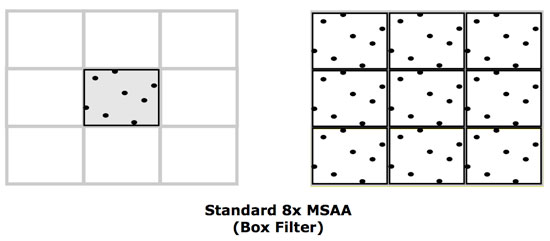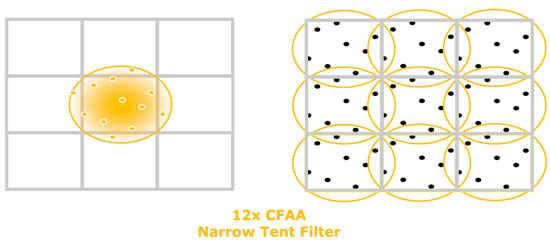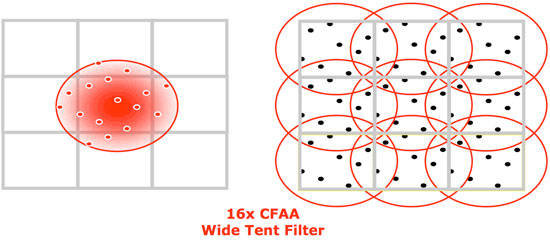ATI Radeon HD 2900 XT: Calling a Spade a Spade
by Derek Wilson on May 14, 2007 12:04 PM EST- Posted in
- GPUs
CFAA and No Fixed Resolve Hardware
That's right, R600 doesn't have hardware dedicated to resolving MSAA in the render back end - the only MSAA related tasks handled in the render back end are compression and evaluation of the subpixels. All antialiasing resolve is performed on the shader hardware. Certainly, AMD would prefer we start by telling you about the neat custom resolve filters that can be implemented on their shader hardware, but we would rather speculate about this for a moment first.
AMD has stated that, moving forward, in addition to allowing programmable sample patterns, future DX versions may allow for custom resolve filters as well. This is cited as one of the reasons why R600 uses shader hardware to resolve AA samples. AMD has given us a couple different resolve filters to play with, which we'll talk about in a minute. But at a point where we're seeing the first DX10 hardware from graphics makers, and at a time where competitive performance is paramount, it doesn't seem like the decision we would have made.
Whatever the circumstances, R600 sends its pixels back up from the render back ends to the shader hardware to combine subpixel data into a final pixel color. In addition to the traditional "box" filter (which uses subpixels within the area of a single pixel), the new driver offers the ability to use subpixel data from neighboring pixels resolved with a tent filter (where the impact of the subpixels on final color is weighted by distance). AMD calls this CFAA for custom filter antialiasing.

AMD currently offers narrow and wide tent filters which can be implemented using 2, 4, or 8 multisamples per pixel boundary. This gives us nine different AA options including traditional box filters. More filter options can be provided via driver updates, as these are essentially driver managed shader programs. Here's the breakdown of the options based on the type of filter and the number of samples used to resolve each pixel.



One of the useful side effects of these tent filters is that they are also capable of antialiasing interior pixels, not just those covered by more than one triangle. This is helpful in getting rid of aliasing in textures which can occur in certain cases.
While tent filters are a very interesting idea to improve antialiasing, they are not without their drawbacks. First, it is possible for tent filters, even though neighboring subpixel data is weighted less than internal subpixels, to create a muddy look, especially with high contrast fine detail like thin text for example. While tent filters can antialias textures on interior pixels, they can also create a blur effect where it isn't needed which removes detail from the scene.
Edge Detection
While tent filters are good in the general edge case, in order to be really compelling from an image quality stand point, AMD decided to go a step further and adaptively apply more AA in places where it would do the most good and less elsewhere. This will be done by applying an edge detect algorithm to the framebuffer and using more aggressive AA on these edges.
We learned that edge detection can be sped up by looking at pixel compression. If all the subpixels for one fragment are the same color, compression will be at its highest and there is no edge within that pixel. Beyond using this information, we are told that the algorithm uses straightforward derivative computations to find high frequency data (high contrast edges) much the same way Photoshop does.
The combination of edge detection and tent filters gives us two extra option beyond the ones listed above: 12x narrow tent filter with edge detect and 24x wide tent filter with edge detect. These filters are capable of very good image quality, though this quality does come at a performance cost. We will take a look at performance and image quality after we finish going through R600 hardware.










86 Comments
View All Comments
GoatMonkey - Monday, May 14, 2007 - link
That's obviously BS. This IS their high end part, it just doesn't perform as well as nVidia's high end part, so it is priced accordingly.poohbear - Monday, May 14, 2007 - link
sweet review though! thanks for including all the important and pertinent cards in your roundup (the 8800gts 320mb inparticular). also love how neutral Anand is in their reviews, unlike some other sites.:pCreig - Monday, May 14, 2007 - link
The R600 is finally here. I'm sure the overall performance is not what AMD was hoping for. Nobody ever shoots to have their newest product be the 2nd best. But pricing it at $399 and including a very nice game bundle will make the HD 2900 XT a VERY worthwhile purchase. I also have the feeling that there is a significant amount of performance increase to be realized through future driver releases ala X1800XT.shady28 - Tuesday, May 15, 2007 - link
Nvidia has gone over the cliff on pricing.
I know of no one personally who has an 88xx series card. I know one who recently picked up an 8600 of some kind, that's it. I have the best GPU of anyone I know.
It's a real shame that there is so much focus on graphics cards that virtually no one buys. These are niche products folks - yet 'who is best' seems to be totally dependent on these niche products. That's patently ridiculous.
It's like saying, since IBM makes the fastest computers in the world (they do), they're the best and you should be buying IBM (or now, lenovo) laptops and desktops.
No one ever said that sort of thing because it's patently ridiculous. Why do people say it now for graphics cards? The fact that they do says a lot about the mentality of sites like AT.
DerekWilson - Tuesday, May 15, 2007 - link
We don't say what you are implying, and we are also very upset with some of NVIDIA's pricing (specifically the 8800 ultra)the 8800 gts 320mb is one of the best values for your money anywhere and isn't crazy expensive -- it's actually the card I'd recommend to anyone who cares about graphics in games and wants good quality and performance at 1600x1200.
I would never tell anyone to buy an 8600 gts because nvidia has the fastest high end card. In fact, in this article, I hope I made it clear that AMD has the opportunity to capitalize on the huge performance gap nvidia left between the 8600 and 8800 series ... If AMD builds a part that performs in this range is priced competitively, they'll have our recommendation in a flash.
Recommending parts based on value at each price or performance segment is something we take pride in and will always do, no matter who has the absolute fastest hardware out there.
The reason our focus was on AMD's fastest part is because they haven't given us any other hardware to test. We will absolutely be talking a lot and in much depth about midrange and budget hardware when AMD makes these parts available to us.
yacoub - Monday, May 14, 2007 - link
$400 is a lot of money. Not terribly long ago the highest end GPU available didn't cost more than $400. Now they hit $750 so you start to think $400 sounds cheap. It's really not. It's a heck of a lot of money for one piece of hardware. You can put together a 650i SLI rig with 2GB of DDR2 6400 and an E4400 for that much money. I know because I just did that. I kept my 7900GT from my old rig because I wanted to see how R600 did before purchasing an 8800GTS 640MB. Now that we've seen initial results I will wait to see how R600 does with more mature drivers and also wait to see the 640MB GTS price come down even more in the meantime.vijay333 - Monday, May 14, 2007 - link
http://www.randomhouse.com/wotd/index.pperl?date=1...">http://www.randomhouse.com/wotd/index.pperl?date=1..."the expression to call a spade a spade is thousands of years old and etymologically has nothing whatsoever to do with any racial sentiment."
yacoub - Monday, May 14, 2007 - link
Yes, a spade was a shovel long before muslims enslaved europeans to do hard labor in north africa and europeans enslaved africans to do hard labor in the 'new world'.vijay333 - Monday, May 14, 2007 - link
whoops...replied to the wrong one.rADo2 - Monday, May 14, 2007 - link
It is not 2nd best (after 8800ULTRA), not 3rd best (after 8800GTX), not 4th best (after 8800GTX-640), but 5th best (after 8800GTS-320), or even worse ;)Bad performance with AA turned on (everybody turns on AA), huge power consumption, late to the market.
A definitive failure.